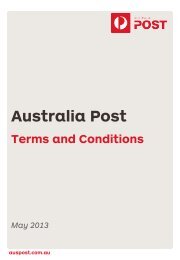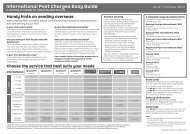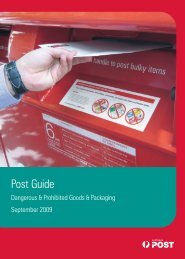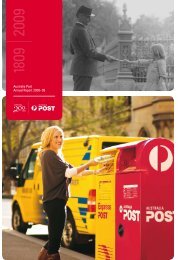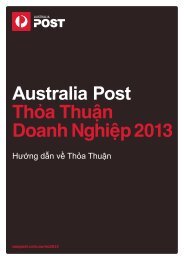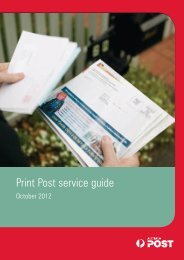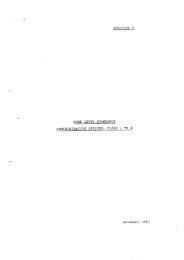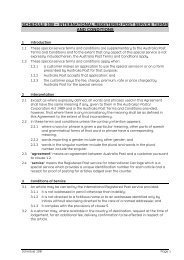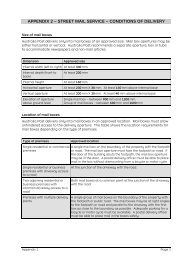2004-05 Annual Report - Australia Post
2004-05 Annual Report - Australia Post
2004-05 Annual Report - Australia Post
You also want an ePaper? Increase the reach of your titles
YUMPU automatically turns print PDFs into web optimized ePapers that Google loves.
<strong>Australia</strong> <strong>Post</strong> <strong>Annual</strong> <strong>Report</strong> <strong>2004</strong>/<strong>05</strong> Financial and Statutory <strong>Report</strong>s<br />
Notes to and forming part of the financial statements<br />
| 70 |<br />
NOTES TO AND FORMING PART OF THE FINANCIAL STATEMENTS<br />
FOR THE YEAR ENDED 30 JUNE 20<strong>05</strong><br />
(e) Dividends<br />
A provision for dividend is not recognised as a liability<br />
unless the dividend is declared, determined or publicly<br />
recommended on or before the reporting date.<br />
(f) Cash<br />
Cash on hand and in financial institutions and on<br />
short-term deposit are stated at nominal value. Cash<br />
includes certain receipts relating to the corporation’s<br />
agency arrangements. These amounts are payable to<br />
the various principals (refer note 17).<br />
(g) Receivables<br />
Trade receivables are recognised and carried at original<br />
invoice amount less a provision for any uncollectible<br />
debts. Terms are 14 days. An estimate for doubtful<br />
debts is made when collection of the full amount is no<br />
longer probable. Bad debts are written off as incurred.<br />
(h) Inventories<br />
Raw materials, work in progress and finished goods<br />
are stated at the lower of cost and net realisable<br />
value. For products manufactured by the corporation,<br />
cost comprises direct materials, direct labour and an<br />
appropriate proportion of variable and fixed overhead<br />
expenditure. Costs are assigned to inventory quantities<br />
on hand at balance date on the basis of weighted<br />
average costs. Inventory on hand at balance date is<br />
held for resale.<br />
(i) Investments<br />
Interests in joint-venture entities, over which the<br />
corporation exercises significant influence but not<br />
control, are accounted for in the consolidated financial<br />
statements using the equity method and at the lower<br />
of cost and recoverable amount in the corporation’s<br />
own statements. Under the equity method, the<br />
corporation’s share of the post-acquisition profits or<br />
losses of the joint-venture is recognised as revenue<br />
or expense in the consolidated Statement of Financial<br />
Performance and its share of movements in reserves<br />
is recognised in consolidated reserves. The cumulative<br />
post-acquisition movements are adjusted against the<br />
cost of the investment.<br />
Interests in joint-venture partnerships are equity<br />
accounted on consolidation and in the corporation’s<br />
statements. All other non-current investments are<br />
carried at the lower of cost and recoverable amount.<br />
(j) Leased assets<br />
In the case of operational leases, where the risks and<br />
benefits remain with the lessor, lease payments are<br />
charged as expense to net profit or loss in the periods<br />
in which they are incurred.<br />
In the case of assets acquired under finance leases,<br />
where substantially all the risks and benefits transfer to<br />
the corporation, the non-current asset is capitalised at<br />
the present value of minimum lease payments at the<br />
inception of the lease and a liability recognised for the<br />
same amount. Leased assets are amortised over the<br />
term of the lease. Lease payments are allocated between<br />
interest expense and reduction in the lease liability.<br />
The corporation entered sale and leaseback<br />
transactions for certain plant and equipment assets<br />
during the years ended 30 June 2000 and 30 June<br />
2001. The carrying amounts of these assets<br />
were written down to fair value at the date of the<br />
transactions and the consequent profit on sale is<br />
being amortised over the lower of the remaining<br />
useful life of the assets and the lease term. These<br />
assets have been valued using the same methodology<br />
as specialised plant and equipment that is owned.<br />
(k) Property, plant and equipment (PP&E)<br />
(i) Initial recognition<br />
Purchases of property, plant and equipment are<br />
recognised initially at cost, with the exception of<br />
plant and equipment under one thousand dollars<br />
(and not part of a major re-equipment program)<br />
which is expensed in the year of acquisition.<br />
(ii) Basis of revaluation<br />
Land and buildings<br />
Property revaluations undertaken are subject to<br />
revaluation on a fair value basis in accordance<br />
with Finance Minister’s Orders.<br />
Land and buildings consists of:<br />
° special-purpose buildings – facilities purpose built to<br />
meet the mail processing and network requirements<br />
of the corporation’s mail services<br />
° general-purpose buildings – owned freehold<br />
properties not included in the special purpose<br />
class and improvements to properties on leased<br />
land. This includes post offices, administrative and<br />
operational support facilities.<br />
Special-purpose properties are valued using a<br />
market price assuming continued occupation by the<br />
corporation. General-purpose properties are valued<br />
using a market selling price.<br />
Assets which are surplus to requirements are<br />
measured at their expected net realisable value.<br />
At 30 June 20<strong>05</strong> the corporation held surplus property<br />
assets estimated to realise $21.6 million (30 June<br />
<strong>2004</strong>, $21.8 million).<br />
Plant and equipment (P&E)<br />
Plant and equipment assets are subject to revaluation<br />
on a fair value basis in accordance with Finance<br />
Minister’s Orders.<br />
Plant and equipment consists of:<br />
° specialised plant and equipment – items that are<br />
specific to the mail handling, retail and agency<br />
operations including letter, parcel, retail and agency<br />
systems<br />
° non-specialised plant and equipment – items that<br />
have general usage in industrial and commercial<br />
operations such as motor vehicles, stores handling<br />
equipment, office furniture and retail fixtures and<br />
fittings.<br />
For specialised plant and equipment, where no active<br />
market exists for assets of similar use, type and<br />
condition, fair value is established for cash generating<br />
units using the net present value (NPV) of future cash<br />
flows that arise from the highest and best use of the<br />
cash generating unit. Where the NPV of these cash<br />
flows is greater than the written-down current cost<br />
(WDCC), fair value is recorded as the WDCC. Where<br />
the NPV of these cash flows is less than the WDCC,<br />
fair value is recorded at the WDCC reduced pro-rata by<br />
the excess of WDCC over the NPV of these cash flows.




